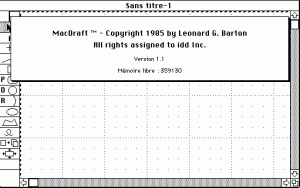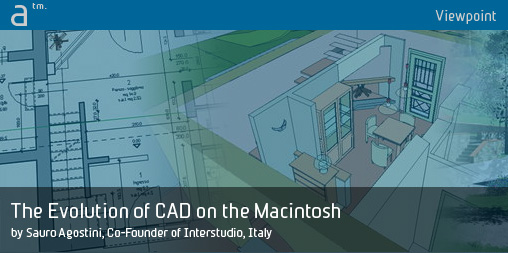Introduction
When the first Macintosh 128k came out in 1984, it had three programs, each of which–in their own way–were the basis for generations of other programs, many of which are commonly used today. These programs were MacWrite, MacPaint and MacDraw (for vectorial drawing).
All three used the new graphic user interface and a new pointing device called a “mouse.” Also, they were all WYSIWYG (What You See Is What You Get)–what you see on the monitor is what comes out when printed.
Nowadays this seems normal, but then, it wasn’t. In fact, even today many CAD users, particularly AutoCAD, do not adopt this philosophy, and the video and print versions of the drawing are completely different.

01 – The original Macintosh 128k shipped with three software applications built in that were the origins of most modern software today (image courtesy of Interstudio, Italy, All rights Reserved.)
MacWrite was the prototype of all word processing software that followed, including Microsoft Word, whose first version was created on and for the Macintosh. MacPaint was the prototype of all painting software that followed, starting from Adobe Photoshop, whose first version was created on the Mac.

02 – Early versions of CAD on Mac, like MacDraft, were based on Apple’s MacDraw vectorial drawing application. (image courtesy of Interstudio, Italy, All rights Reserved.)
MacDraw was the prototype of all vectorial graphic software such as Freehand and Illustrator, these too were created on Macintosh, as well as for a series of CAD programs that borrowed from MacDraw the concepts of a simple, intuitive user interface and visual control of the final result. Of these early CADs, we might mention MacDraft, PowerDraw and MiniCAD. Soon after came the architectural programs Radar CH, Architrion and Domus.Cad.
Here, however, right from the start there was a big difference between the Mac CAD programs, deriving from the MacDraw philosophy with its mouse pointing device, and the CAD programs, first on DOS and later Windows, deriving from the Command Line philosophy. These DOS descending CADs had the pointing device as the tablet–as in the concept of CAD on workstations–used also by AutoCAD of Autodesk. This became particularly evident in 1992 when Autodesk released AutoCAD 12 for Macintosh. The software was completely “snubbed” by Mac users and very few of them bought it, preferring to continue using programs created on the Macintosh, with a MacDraw philosophy-based user interface.
Two Differing Philosophies
The principle underlying CAD software for Mac was, as stated, to have on screen an exact representation of the final printout–so a white background like paper, thicknesses as they would be printed and use of printed colors. The pointing device was the mouse.

03 – Autodesk’s AutoCAD 2000, like all DOS-originated Windows CADs of the time derived from a different philosophy based in the command line and tablets of workstations. (image courtesy of Interstudio, Italy, All rights Reserved.)
In the beginning Windows did not exist and PCs were heavily DOS-reliant. CAD software on DOS grew out of the CAD workstation philosophy, where the pointing device was the tablet and the command line was text. Even when Windows came along nothing changed. CAD for Windows had a black background, the lines all had the same thickness, the colors were used to represent different thicknesses and the end result was not clear until the drawing had been printed or plotted.
In CAD for Mac, commands were mainly carried out by the mouse using the Select-Command. That is, you selected some elements and then you could use a series of functions on the selected items–move, rotate, change color, change thickness, et cetera–as we now do using today’s word processing software.
In CAD for Windows, commands were mostly given by command lines. And even when the tablet or mouse were used, it was always Command-Select. For example, to move something, you clicked on the Move icon and then indicated the elements to be moved. To cancel, you clicked on the cancel icon, after which you indicated elements to canceled. And so on.
Another example was the integration with the operating system. Generally, CAD programs for Mac were highly integrated with the functions of the operating system. It was normal to copy/paste from one program to another, even if they were very different. For example, you could select a part of a CAD drawing and paste it into a report in the word processing program. Nowadays this seems all very normal, but in the 1980’s it seemed like a miracle. The programs, at first simple, incomplete even, grew bit by bit, along with the potential of the operating system, in an organic and innovative way, without being chained to the past.
Programs for DOS and Windows, not only AutoCAD, but also MicroStation, VersaCAD and others, were a subset of more powerful and complete programs created on workstations like Sun, SGI and mini-computers like Digital, with various types of compromise. These programs also grew and improved over time, overtaking their “programs of origin” for power and functions, but without abandoning the original philosophy.
Next Page: The Rise of 3D Architectural CADs




Reader Comments
[…] Vedi l’articolo su Architosh … […]
Comments are closed.